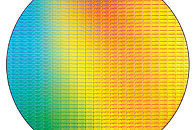- Joined
- Oct 9, 2007
- Messages
- 47,635 (7.44/day)
- Location
- Dublin, Ireland
| System Name | RBMK-1000 |
|---|---|
| Processor | AMD Ryzen 7 5700G |
| Motherboard | Gigabyte B550 AORUS Elite V2 |
| Cooling | DeepCool Gammax L240 V2 |
| Memory | 2x 16GB DDR4-3200 |
| Video Card(s) | Galax RTX 4070 Ti EX |
| Storage | Samsung 990 1TB |
| Display(s) | BenQ 1440p 60 Hz 27-inch |
| Case | Corsair Carbide 100R |
| Audio Device(s) | ASUS SupremeFX S1220A |
| Power Supply | Cooler Master MWE Gold 650W |
| Mouse | ASUS ROG Strix Impact |
| Keyboard | Gamdias Hermes E2 |
| Software | Windows 11 Pro |
Intel co-founder Gordon Moore's claim that transistor counts in microprocessors can be doubled with 2 years, by means of miniaturizing silicon lithography is beginning to buckle. In its latest earnings release, CEO Brian Krzanich said that the company's recent product cycles marked a slowing down of its "tick-tock" product development from 2 years to close to 2.5 years. With the company approaching sub-10 nm scales, it's bound to stay that way.
To keep Moore's Law alive, Intel adopted a product development strategy it calls tick-tock. Think of it as a metronome that give rhythm to the company. Each "tock" marks the arrival of a new micro-architecture, and each "tick" marks its miniaturization to a smaller silicon fab process. Normally, each year is bound to see one of the two in alternation.

"Penryn" was Intel's first 45 nm chip and miniaturization of "Conroe", "Nehalem" was a newer architecture on 45 nm, "Westmere" was its miniaturization to 32 nm, "Sandy Bridge" was a newer architecture on 32 nm, "Ivy Bridge" was its miniaturization to 22 nm, "Haswell" was a new architecture on 22 nm, and "Broadwell" is its miniaturization to 14 nm. "Skylake" is a new architecture on 14 nm. It was all well and good until "Broadwell."
Intel approached "Broadwell" slower than expected, because implementing the 14 nm node took longer. Intel launched its "Haswell Refresh" silicon to hold ground over mid-2014 to mid-2015. To compensate for lost ground, the company allowed "Broadwell" to be cannibalized by an on-schedule "Skylake" launch. The two less-than-memorable Broadwell desktop chips, the i7-5775C and i5-5675C, are tough to find in the retail market.
Krzanich suggested that the company could face a similarly slow product development cycle as it approaches the limits of how small it can make its chips using existing materials. With "Skylake" out this August, it could be a while before you see its miniaturization to 10 nm, codenamed "Cannonlake." IBM has had better luck with sub-10 nm. The company recently demonstrated a 7 nm chip built with a new silicon-germanium alloy substrate. IBM recently sold the division responsible for this in-toto, to GlobalFoundries, the principal foundry partner of AMD. Krzanich concluded that Moore's Law is still "alive and safe," and that it's not the first time it faced difficulties.
View at TechPowerUp Main Site
To keep Moore's Law alive, Intel adopted a product development strategy it calls tick-tock. Think of it as a metronome that give rhythm to the company. Each "tock" marks the arrival of a new micro-architecture, and each "tick" marks its miniaturization to a smaller silicon fab process. Normally, each year is bound to see one of the two in alternation.

"Penryn" was Intel's first 45 nm chip and miniaturization of "Conroe", "Nehalem" was a newer architecture on 45 nm, "Westmere" was its miniaturization to 32 nm, "Sandy Bridge" was a newer architecture on 32 nm, "Ivy Bridge" was its miniaturization to 22 nm, "Haswell" was a new architecture on 22 nm, and "Broadwell" is its miniaturization to 14 nm. "Skylake" is a new architecture on 14 nm. It was all well and good until "Broadwell."
Intel approached "Broadwell" slower than expected, because implementing the 14 nm node took longer. Intel launched its "Haswell Refresh" silicon to hold ground over mid-2014 to mid-2015. To compensate for lost ground, the company allowed "Broadwell" to be cannibalized by an on-schedule "Skylake" launch. The two less-than-memorable Broadwell desktop chips, the i7-5775C and i5-5675C, are tough to find in the retail market.
Krzanich suggested that the company could face a similarly slow product development cycle as it approaches the limits of how small it can make its chips using existing materials. With "Skylake" out this August, it could be a while before you see its miniaturization to 10 nm, codenamed "Cannonlake." IBM has had better luck with sub-10 nm. The company recently demonstrated a 7 nm chip built with a new silicon-germanium alloy substrate. IBM recently sold the division responsible for this in-toto, to GlobalFoundries, the principal foundry partner of AMD. Krzanich concluded that Moore's Law is still "alive and safe," and that it's not the first time it faced difficulties.
View at TechPowerUp Main Site






